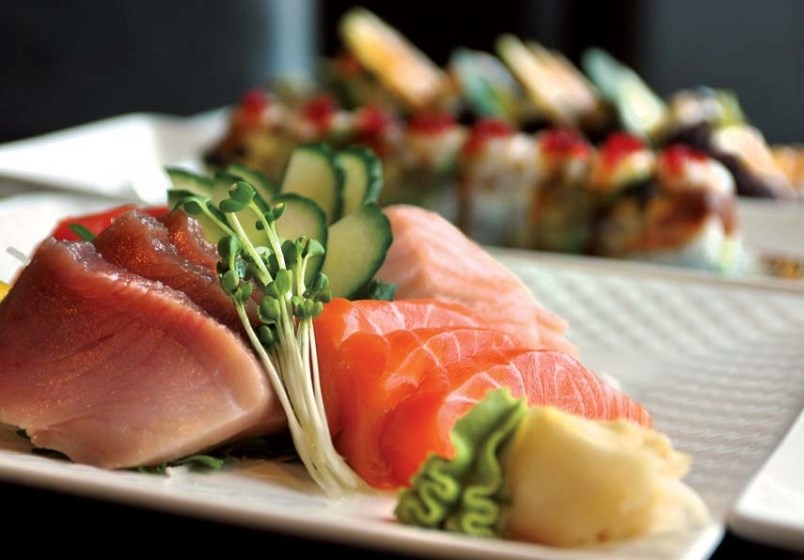If you’ve grown up in the Vancouver area you may not realize what an oddity the whole sushi thing still is for many people from other parts of the country.
I grew up in a small Prairie town where there were only two types of fish available: triangle and rectangle. It was all prepared by a multi-talented fellow who also apparently drove the boat. Cheers to you, Capt. High Liner.
For us Prairie folk, sushi was like some made-up joke food that you’d never actually eat, like frogs’ legs or caviar or vegetables. Raw fish? Gross. No thank you. I’ll have a T-bone steak, still mooing please and thank you.
You can get sushi in many other parts of the country now, but that doesn’t mean you should get sushi in other parts of the country. Obviously things are different out here, where municipal bylaws stipulate that you must never be more than six city blocks away from Kappa Maki.
Here’s a neat science experiment you can try on your own. Head down to any Lower Mainland beach during low tide and lay a cardboard box in the sand. When you come back the next day, the box will be a sushi restaurant.
I first tried sushi when I was 24 years old. It tasted like salt, and fear. Contrast that with my North Shore-born children who have been eating sushi since they were nine months old. It’s a different world for them.
Here’s the weird part, though: just by sheer proxy of me living here for the past decade or so, I now am Iron Chef Sushi compared to my friends and relatives from the Prairies. Just last week another one of my friends came out here and mustered the courage to try the West Coast sushi experience, asking me to be his guide on the journey.
Going through that process made me realize that there are still many good, salt-of-the-earth folks for whom sushi is still a mystery. I want to help change that, demystify things a bit. What I came up with is this handy cheat sheet to help even the most skittish sushi rookie get a taste for something new. Here it is: the Redneck’s Guide to Sushi.
Price: Before you even get in the door for your first sushi experience, make sure that you are going to a place that is suitably cheap. All sushi in Vancouver is pretty good, and it all tastes mostly the same to those with untrained palettes, so don’t bother trying to find some fancy sushi joint where they expect you to pay real restaurant prices. When you get to Vancouver just walk 50 paces in any direction and you are guaranteed to bump into a man with sharp knives and a white hat who will sell you good sushi for cheap.
Miso soup: From the Japanese words “miso,” meaning “me so,” and “soup,” meaning “salty,” many sushi orders first come with a bowl that contains two bits of green floaties and three cubes of tofu trapped inside a weird broth within a broth that expands and contracts like some sort of salty lava lamp. As far as I know these soups are purely decorative.
Tempura: From the Japanese words “tempe” meaning “fried,” and “ura,” meaning “stuff,” this is some easy-to-eat food that can ease even the most timid landlubbers into the sushi experience. Heck, prawn tempura is so yummy and unchallenging it could almost be called regular food.
Rolls: Now you’re ready for the real deal. The rolls are where the adventure really begins, and most likely ends for most newbies. They are made with a seaweed square that is laid on a bed of sticky rice, filled with stuff like avocado, cucumber, real crab, fake crab, or barbecued eel, and then rolled into cylinders and cut into bite-sized pieces. Mmmm. Eel.
Don’t worry too much about what is inside these rolls because you are going to drown them in so much soy sauce that each piece will look like a soggy little hockey puck and taste like a heart attack.
Each roll comes with a pile of shaved ginger, because this meal wasn’t weird enough yet. Rolls also come with “wasabi,” which is a Japanese word meaning “green death paste.” It is similar to horseradish in that it is not so much a good-tasting food and more of a test of your ability to stay calm while eating super-spiced playdough. Pro tip: start small.
Chop sticks: You will be using two round sticks held in one hand to pick up dense, heavy, slippery food circles. What could go wrong?!
Try to also remember to eat each piece in one bite, no matter how big the circle is. Trying to eat sushi in two bites is like trying to eat a Bic pen in two bites. It’s going to get messy.
Dry cleaner: The perfect end to any first-time sushi experience.
There are other parts to a sushi dinner, such as sashimi, the famous delicacy consisting of very fresh raw fish that is sliced into thin pieces, often plated in a dazzling display that allows the sushi chef’s exquisite knife skills to shine through. You are not going to eat this.
If you’re a real coward, there are also things like yakitori and udon, simple skewers and noodle soups that really aren’t part of the truly exotic sushi experience. I ate a ton of yakitori in my early sushi days. But you don’t have to, because you’ve got this guide. You’re ready!
And thus ends your exciting introduction to sushi! Be careful on your way out of the restaurant – it looks like it’s high tide.



